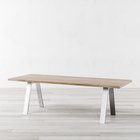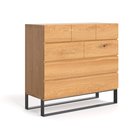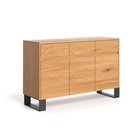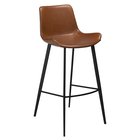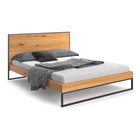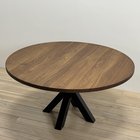When selecting dining tables, height and proportions significantly impact ergonomics and design harmony. Standard dimensions exist for essential table types and seating. But adjustable integrated features also facilitate tweaking table specifications to changing requirements. This article outlines ideal dining table height by function, critical height-to-chair ratios, custom-fit measurement tips and adaptable table capabilities to suit any lifestyle.
Understanding Standard Dining Table Height
The standard height of dining room table plays a vital role in the comfort and functionality of your eating space. This section breaks down the average dining table dimensions height and how it relates to your experience.
Factors Setting Effective Table Height
Table height directly impacts these essential factors:
- Seating Comfort
- Space Proportions
- Serving Convenience
- Design Aesthetic
Matching table and seating heights prevents uncomfortable reaching strain while eating. The scale also needs to harmonize attractively with room architecture for balanced proportions. Understanding measurements as they relate to these ergonomic and visual objectives helps you determine the optimal table height.
Dining versus Bar/Counter Table Height
Dining Table Height
In most eating rooms, table height hits around 30 inches as the norm. This size comfortably accommodates the standard dining chair height averaging 15-18 inches. With chairs pulled in, ample knee clearance remains below the underside surface too. This unity between furnishings streamlines proportions from a visual standpoint as well.
Bar/Counter Table Height
For bar-forward designs, table height increases to 36-42 inches aligning with typical bar stool seat heights from 24-30 inches. The taller height enables comfortable elbow placement for dining at stool depth. It also facilitates multi-tasking as a kitchen prep space or home office desk when not set for a meal. The bar-forward stool seating communicates casual open-concept gathering above strict formal as well.
What’s the Right Size Range?
Use these recommended measurements to identify table height for your planned usage:
Dining Room Tables
- Casual – 28-30 inches
- Standard – 30 inches
- Formal – 30-32 inches
Kitchen & Multi-Use Tables
- Kitchen/Dining Combo – 30-36 inches (Accommodates both dining chairs and some counter stool seating)
- Bar/Counter Height – 36-42 inches
- Stand-up Height – 42+ inches (For commercial use or higher fixed bar-style seating applications)
Coffee Tables and Occasional Tables
- Casual/Coffee Table Height – 16-24 inches
(Allows seated floor access but high enough to tuck knees under if desired).
Kitchen Table Height Considerations
Kitchen table height, where space and versatility are often more crucial, the height can vary based on specific needs and styles.
Small Kitchen Spaces
Standard Height Tables: These are often best for smaller kitchens, helping to keep the area open and versatile for various activities.
Larger Kitchens with Islands
In larger kitchens, especially those with islands, counter or bar height tables can add a dynamic element to the space.
Measure for Ideal Chair-and-Table Proportions
Always buy table and chairs as intentional pairings matched flush in height and scale. As a rule of thumb:
- Kitchen chair seat height averages 15-18 inches
- Bar stool seat height averages 24-30 inches
So for a kitchen hosting both sit-down meals and casual drink prep or standalone seating, select adjustable stools allowing seat height to toggle between full bar and dining options as needed.
Likewise, modify table height to bridge room functions using furniture with alteration capabilities. For example, install hydraulic base risers to raise a table from 30 to 36 inches when extra counter area takes priority over fully-seated dinner parties.
Designing versatile environments around adaptable furnishings directly supports maximizing valuable square footage in great rooms and open-concept spaces.
Getting Dining Table Dimensions Right
Beyond determining accurate height, ensure ample table dimensions otherwise:
- At least 36 inches width per diner
- Approximately 24-30 inches depth front to back
Built-in expansion leaves or large drop leaf sides help accommodate fluctuating head counts as required. Just keep ergonomics and clearances in mind so guests can utilize added seating when deployed.
Ergonomic Importance: Why the Right Table Height Matters
The height of your dining table is more than just a design choice; it's a crucial factor in ensuring ergonomic comfort. A table that aligns well with the height of its chairs allows diners to sit with their feet flat on the floor and their arms at a comfortable angle, reducing the risk of back or neck strain.
This proper alignment encourages a more natural, upright posture during meals, which is essential for long-term spinal health. By choosing a table height that facilitates a relaxed yet supportive dining position, you enhance not only the aesthetic of your dining space but also the overall dining experience, prioritizing comfort and well-being.
Height Adaptability
Several adjustable table systems allow you to modify the height as needs change. Self-leveling bases use interior hydraulic pumps activated by a handle or pedal lever to raise or lower table frames smoothly. Some models include programmable presets registering multiple height positions. Telescoping pedestal bases insert or remove nested height extension tubes secured by tension pins across a 20-inch range up to 42 inches.
Modular table tops can also detach or extend thanks to built-in interface brackets, side leaves, and converter panels blending multiple tables seamlessly both in form and finish. Explore mix-and-match components to create fully personalized eating experiences through clever and functional furniture.
Selecting the Best Height for Your Furniture Set
When selecting the height for your dining set, consider the following:
- Comfort: Ensure that the table height is comfortable for all family members and guests.
- Functionality: Consider how the table will be used. For meals, standard height is often best, while tall tables are great for socializing.
- Aesthetics: Choose a height that complements the design and style of your eating room or kitchen.
Closing Thoughts
Carefully calculated proportions make all the difference in both aesthetics and practical comfort when sizing a multipurpose dining table. Reference standard measurements as guides then customize the height to your planned seating, style, and activities.





